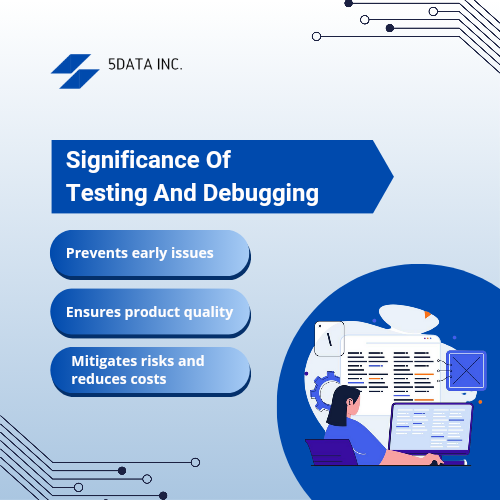Application development using any programming language is a complex and iterative process that involves design knowledge, software code, automation testing, and deploying software applications. While each stage of development holds its importance, the software testing process plays a critical role in ensuring the quality and reliability of the final product. This article will delve into the significance of software testing and debugging in application development, exploring their purpose, methodologies, and best practices.
Website Performance Testing Companies optimize websites for seamless performance across all devices. Their expertise ensures websites can handle high traffic volumes without crashing or experiencing significant slowdowns. Conducting rigorous testing guarantees that web pages remain stable and responsive, delivering a smooth user experience.
Understanding Testing In Application Development
Importance of Testing
Ensuring functionality and performance: Testing verifies that the application functions as intended and meets the specified requirements. Identifies any functionality-related issues, ensuring all features work correctly and are bug-free. Performance testing and automation tools evaluate an application’s speed, responsiveness, and scalability.Detecting and fixing defects: Developers can identify bugs and resolve defects by manually debugging and testing the code. The software testing process ensures that the code will execute properly and improve the overall quality and reliability of the application, reducing errors, crashes, or unexpected behaviors.Enhancing user experience and satisfaction: Developers use several testing methods to evaluate the application’s user interface, usability, and overall end-user experience. Developers can create an intuitive and enjoyable client interface by addressing usability issues and refining the interface.Mitigating risks and reducing cost: Thorough testing helps error detection and allows error correction, thus helping in mitigating potential risks associated with security vulnerabilities, data structures, and software fails. Early detection and resolution of issues reduce the cost of fixing problems in later stages of development or even after the application has been deployed.Types of Testing
- Unit Testing: Testing individual components or modules of the application in isolation to ensure they function correctly.
- Integration Testing: Testing the interaction and compatibility between different components or modules to ensure they work together seamlessly.
- System Testing: Testing the application to verify that it meets the specified requirements and functions in different scenarios.
- Acceptance Testing: Evaluating the application’s compliance with user requirements and determining if it is ready for deployment.
The Debugging Process In Application Development
Understanding Debugging
The debugging process identifies, analyzes, and fixes defects or bugs found in the application’s code. Debugging is crucial in ensuring the smooth operation of software product development.Definition and purpose: The debugging process involves identifying and rectifying issues that arise during software testing or in the live environment. It aims at removing errors and unexpected behaviors, ensuring the application’s functionality.Common bugs: Bugs can manifest in various forms, including logical errors, code errors, race conditions, memory leaks, or compatibility issues. Finding bugs while debugging can help the developers to achieve flawless code.Debugging Techniques and Tools
- Print Statements: Inserting print statements within the code to display variable values, function execution paths, and other relevant information.
- Debuggers: Debugging tools integrated into integrated development environments (IDEs) that allow developers to step through the code, set breakpoints, inspect variables, and analyze program flow.
- Logging: Implementing logging mechanisms to capture specific events, errors, or information during application execution for analysis and debugging code.
- Memory Analysis Tools: Specialized tools that help identify memory-related issues, such as memory leaks or excessive memory usage in debugging.
- Time Travel Debugging: It is a technique that enables users to navigate through the source code of a computer program, allowing them to comprehend the program’s execution and interact with it.
Best practices for effective Debugging
- Reproducing the bug: Replicating allows developers to understand the problem and test case potential solutions through debugging.
- Isolating the problem: Narrowing down the scope of the issue helps pinpoint the root cause and reduces unnecessary debugging efforts.
- Analyzing error messages: Thoroughly examining error messages and stack traces provides valuable insights into the root cause of the bug.
- Employing systematic approaches: A step-by-step approach, such as level of divide and conquer or binary search, helps identify the complex testing code or scenario.

The Significance Of Testing And Debugging In The Software Development Process
Preventing issues early in Software Development Life Cycle
- Importance of early testing and debugging: Conducting test cases and debugging processes early in the development cycle allows for quick identification and resolution of issues. It reduces the likelihood of problems propagating to later stages, which can be more complex and costly.
- Provides accuracy and consistency: Top Application Development Companies recognize the significance of automated testing in delivering exceptional services. Automation testing offers consistency, accuracy, and time savings.
- Ensuring requirements are met: Integration testing and debugging time ensure the developed application meets the specified requirements and user expectations.
- Reducing rework and cost: By debugging, detecting, and resolving defects and issues, we can minimize the need for extensive rework, effort, and resources.
Ensuring product quality and reliability
- Detecting and fixing defects: Regression testing aids in detecting bugs and improving the overall quality and reliability of the application.
- Enhancing user satisfaction: Conducting comprehensive system testing enhances debugging by ensuring the application’s desired functionality, delivering a positive user experience, and boosting user satisfaction.
- Meeting performance and security requirements: Testing teams verify that the application meets performance benchmarks and security standards, ensuring a smooth and secure user experience.
Mitigating risks and reducing costs
- Identifying potential vulnerabilities: Comprehensive testing helps identify security vulnerabilities and weaknesses in the application, allowing developers to address them before deployment.
- Reducing the impact of failures: Through testing and debugging, critical errors and failures can be identified and resolved, minimizing the negative impact on users and the business.
- Minimizing maintenance and support costs: The debugging process and testing reduce the likelihood of post-deployment issues, minimizing the need for ongoing maintenance and support.
Conclusion
Testing and debugging prevent issues early in the development cycle, ensure product quality and reliability, mitigate risks, and comply with industry standards. However, challenges such as time and resource constraints, compatibility issues, test coverage, and test data management must be addressed.
Regarding mobile application development, the Best Mobile Application Development Services are offered by software vendors well-versed in mobile testing. By prioritizing testing and debugging throughout the software development life cycle, developers can deliver high-quality applications that meet user requirements, minimize risks, and build stakeholder trust.

Rasmita Patro
Author
